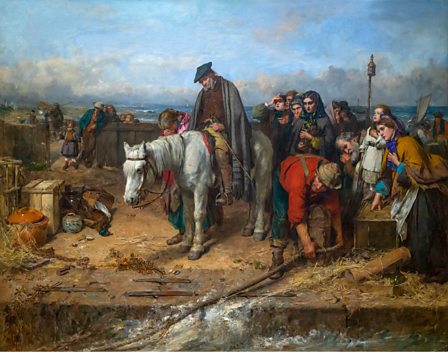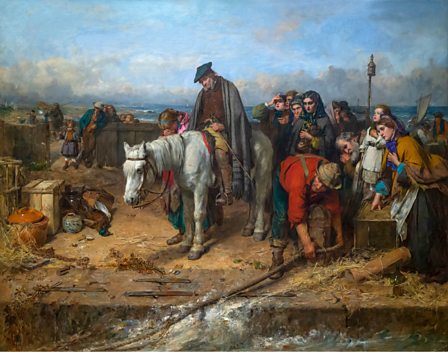
Highland Clearances, was the forced eviction of inhabitants of the Highlands and western islands of Scotland, beginning in the mid-to-late 18th century and continuing intermittently into the mid-19th century. The removals cleared the land of people primarily to allow for the introduction of sheep pastoralism. The Highland Clearances resulted in the destruction of the traditional clan society and began a pattern of rural depopulation and emigration from Scotland. The definition of “clearance” (as it relates to the Highland Clearances) is debatable. The term was not in common use during much of the early clearances; landowners, their factors and other estate staff tended, until the 1840s, to use the word “removal” to refer to the eviction of tenants. However, by 1843, “clearance” had become a general (and derogatory) word to describe the activities of Highland landlords. Its use was ambiguous, as for some it meant only the displacement of large numbers of people from a single place at one time. For others, the eviction of a single tenant at the end of a lease could be termed “clearance” The Highland Clearances (Scottish Gaelic: Fuadaichean nan Gàidheal { the “eviction of the Gaels”} were the evictions of a significant number of tenants in the Scottish Highlands and Islands, mostly in two phases from 1750 to 1860, but some would say it continues to this day The first phase of the clearances resulted from agricultural improvement, driven by the need for landlords to increase their income many had substantial debts, with actual or potential bankruptcy being a large part of the story of the clearances. This involved the enclosure of the open fields managed on the run rig system and shared grazing. These were in most cases usually replaced with large-scale pastoral farms on which much higher rents were paid, with the displaced tenants expected to somehow be employed in industries such as fishing, quarrying or even the kelp industry. The reduction in status from farmer to crofter was one of the causes of resentment. The second phase involved overcrowded crofting communities from the first phase that had lost the means to support themselves, through famine and/or collapse of industries that they had relied on. This is when “assisted passages” were common when landowners paid the fares for their tenants to emigrate. Tenants who were selected for this had, in practical terms, little choice but to emigrate. The Highland Potato Famine struck towards the end of this period, giving greater urgency to the process. The eviction of any tenants went against dùthchas, the principle that clan members had an inalienable right to rent land in the clan territory. This was never recognised in Scottish law. It was gradually abandoned by clan chiefs as they began to think of themselves simply as commercial landlords, rather than as patriarchs of their people a process that arguably started with the Statutes of Iona of 1609. The clan members continued to rely on dùthchas. This difference in viewpoints was an inevitable source of grievance. The actions of landlords varied. Some did try to delay or limit evictions, often to their financial cost. The Countess of Sutherland however misguided genuinely believed her plans were advantageous for those resettled in crofting communities and could not understand why tenants complained when they were evicted. However, many landlords displayed a complete lack of concern for their evicted tenants The very first phase of the Highland Clearances was part of the Scottish Agricultural Revolution but happened later than the same process in the Scottish Lowlands. Scottish agriculture, in general, modernised much more rapidly than in England and, to a large extent, elsewhere in Europe. The ever-growing cities of the Industrial Revolution presented an increased demand for food, and the land came to be seen as an asset to meet this need, and as a source of profit, rather than a means of support for its resident population Before improvement, Highland agriculture was based on run rig arable areas and common land for grazing. Those working in this system lived in townships or bailtean. Under the run rig system, the open fields were divided into equivalent parts, and these were allocated, once a year, to each of the occupiers, who then worked their land individually. With no individual leases or ownership of plots of land, there was little incentive to improve it (for instance by drainage or crop rotation systems). Nor, with common grazing, could an individual owner improve the quality of his stock. The enclosure of the common lands and the run rig fields was a method of improvement. More commonly, there was a greater change in land use: the replacement of mixed farming (in which cattle provided a cash crop) with large-scale sheep farming. This involved displacement of the population to crofts on the same estate, other land in the Highlands, the industrial cities of Scotland or other countries. The common view is that the shepherds employed to manage these flocks were from outside the Highlands. This is an oversimplification, as many of the Gaelic-speaking tacksmen and drovers were to be found in the sheep trade from the 1780s onward. When sheep were introduced in the Sutherland Clearances, over half the leases were taken up by Sutherland Since their origin in the early Middle Ages, clans were the major social unit of the Highlands. They were headed by a clan chief, with members of his family taking positions of authority under him. The mechanisms of clanship gave protection and agricultural land to the clansmen, who in return paid with service and rent which was paid, especially in earlier periods, mostly in kind (as opposed to money). Service included military service when required. The Highlands was one of the parts of Scotland where law and order were not maintained by the central government, hence the need for protection from a powerful leader. Clan leaders controlled the agricultural land, with its distribution generally being achieved through leases to tacksmen, who sublet to the peasant farmers. The basic farming unit was the baile or township, consisting of a few (anything from 4 to 20 or more) families working arable land on the run rig management system, and grazing livestock on common land. Clans provided an effective business model for running the trade in black cattle: the clan gentry managed the collection of those beasts ready for sale and negotiated a price with lowland drovers for all the stock produced on the clan lands. The sale proceeds were offset against the rentals of the individual producers. The growth in the trade in cattle demonstrates the ability of pre-clearance Highland society to adapt to and exploit market opportunities making clear that this was not an immutable social system. James VI was one of the kings who sought to impose control on the Highlands. On becoming James I of England in 1603, he gained the military force to do this. The Statutes of Iona controlled some key aspects; this forced the heirs of the wealthier Highlanders to be educated in the Lowlands and required clan chiefs to appear annually in front of the Privy Council in Edinburgh. This exposed the top layer of Highland society to the costs of living in Edinburgh in a manner fitting to their status. Unlike their Lowland counterparts, their lands were less productive and were not well integrated into the money economy. Large financial sureties were taken from clan leaders to guarantee the good behaviour of the clan. Overall, this reduced the need for the protection provided by a clan whilst increasing the costs for the clan leaders. The clan chiefs who fully subscribed to this new system of regulation were rewarded with charters that formalised their ownership of clan lands. The combination of these initiated the demise of clanship. The process continued as clan chiefs began to think of themselves as landlords, rather than as patriarchs of their people. The various intervals of warfare since the Statutes of Iona reined in the steady transition to landlordism because the ability to raise a band of fighting men at short notice became important again. The civil war that started in 1638 reinvigorated the military aspects. The restoration of Charles II in 1660 brought peace, but it also brought increased taxes, restarting all of the financial pressure. The succession of these Jacobite rebellions emphasised again the martial aspects of clanship, but the defeat at Culloden brought an end to any willingness by the clans to go to war again. This loss of heritable jurisdictions across the whole of Scotland highlighted the changed role of clan chiefs. A tacksman (a member of the daoine uaisle, sometimes described as “gentry” in English) was the holder of a lease or “tack” from the landowner, subletting the land to lesser tenants They were often related to the landowner, even if only distantly. They acted as the middle stratum of pre-clearance society, with a significant role in managing the Highland economy. They were the first sector of Gaelic society to feel the effect of the social and economic changes that included the Clearances, when landlords restricted their power to sub-let, so increasing the rental income directly to the laird; simple-rent increases were also applied. This was part of a slow phasing out of this role; it accelerated from the 1770s, and by the next century, tacksmen were a minor component of society. T. M. Devine describes “the displacement of this class as one of the clearest demonstrations of the death of the old Gaelic society. Many of them emigrated to America, and in the words of Eric Richards: “often cocking a snook at the landlords as they departed”. Emigrating tacksmen, and the larger farmers who departed at the same time, represented not only a flight of capital from Gaeldom but also a loss of entrepreneurial energy In the opinion of T. M. Devine, tacksmen and the middle-ranked tenant farmers represented the economic backbone of the peasant communities of the Western Highlands. Devine repeats the views of Marianne McLean, that those of them who emigrated were not refusing to participate in a commercial economy; rather they rejected the loss of status that the changes of improvement gave them. The first phase of the Clearances occurred mostly over the period 1760 to 1815. However, it started before the Jacobite rebellion of 1745, with its roots in the decision of the Dukes of Argyll to put tacks (or leases) of farms and townships up for auction. This began with Campbell property in Kintyre in the 1710s and spread after 1737 to all of their holdings First phase clearances involved the breakup of the traditional townships which was the essential element of land management in Scottish Gaeldom. These multiple-tenant farms were most often managed by tacksmen. In replacing this system, small individual arable smallholdings or crofts were created, and most of them now shared access to common grazing. This process was accompanied by moving all of the people involved from the interior straths and glens to the coast, where they were expected to find employment in, for example, the kelp or fishing industries. The properties they had formerly occupied were then converted into large sheep holdings. Essentially, therefore, this phase was characterised by relocation rather than outright expulsion. The second phase of clearance started in 1815–20, continuing to the 1850s. It followed the collapse or stagnation of the wartime industries and the continuing rise in population. These economic effects are illustrated by contemporary commodity prices. Kelp had been falling since 1810; in 1823 the market price in Liverpool was £9 a ton, but it fell to £3 13s 4d a ton in 1828, 41% of the 1823 price. Wool prices also shrank over a similar period to a quarter of the price obtained in 1818, and black cattle nearly halved in price between 1810 and the 1830s. In the second phase, the landlords moved to the more draconian policy of expelling people from their estates. This was increasingly associated with ‘assisted emigration’, in which landlords cancelled rent arrears and paid the passage of the redundant families in their estates to North America and, in later years, also to Australia. The process reached a climax during the Highland Potato Famine of 1846–55. However in 1883, in response to growing sympathy for the plight of the crofters, the Napier Commission was established to investigate their condition. In the meantime, the Highland Land Law Reform Association (better known as the Land League) was established. Finally, in 1886, the possibility of future evictions was legally eliminated with Parliament’s passage of the Crofters Holdings Act, which was grounded on the so-called three Fs: fair rent, free sale (the right to become an owner-occupier), and fixity of tenure.



Leave A Comment